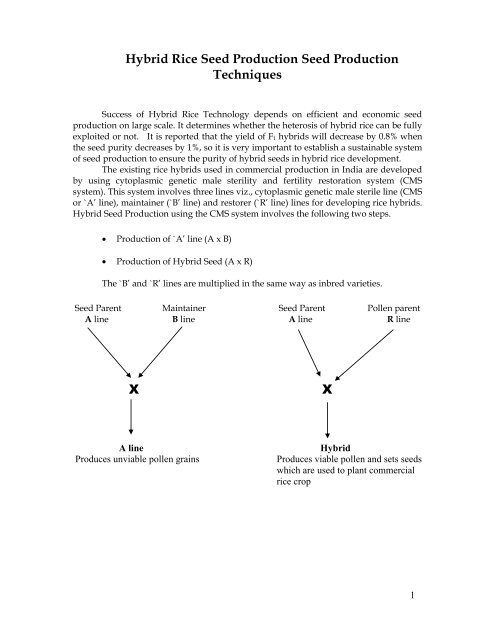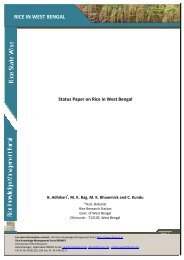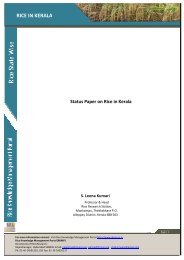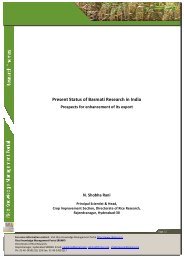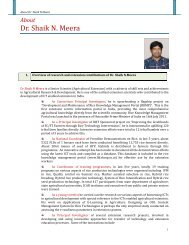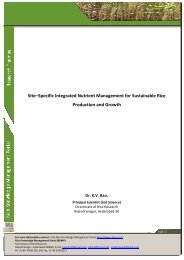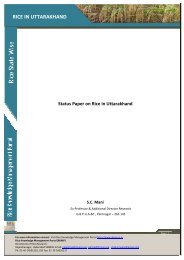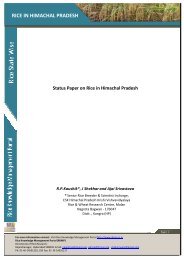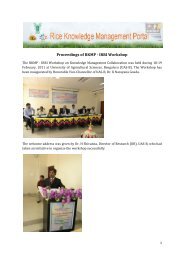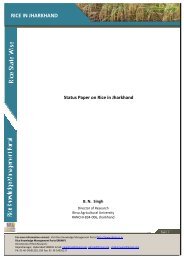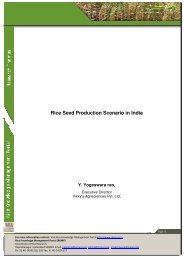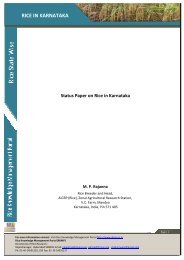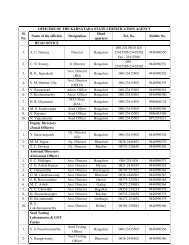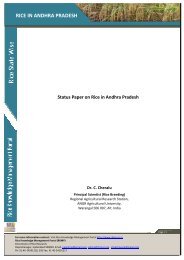Hybrid seed production in paddy-An overview.pdf
Hybrid seed production in paddy-An overview.pdf
Hybrid seed production in paddy-An overview.pdf
You also want an ePaper? Increase the reach of your titles
YUMPU automatically turns print PDFs into web optimized ePapers that Google loves.
<strong>Hybrid</strong> Rice Seed Production Seed Production<br />
Techniques<br />
Success of <strong>Hybrid</strong> Rice Technology depends on efficient and economic <strong>seed</strong><br />
<strong>production</strong> on large scale. It determ<strong>in</strong>es whether the heterosis of hybrid rice can be fully<br />
exploited or not. It is reported that the yield of F 1 hybrids will decrease by 0.8% when<br />
the <strong>seed</strong> purity decreases by 1%, so it is very important to establish a susta<strong>in</strong>able system<br />
of <strong>seed</strong> <strong>production</strong> to ensure the purity of hybrid <strong>seed</strong>s <strong>in</strong> hybrid rice development.<br />
The exist<strong>in</strong>g rice hybrids used <strong>in</strong> commercial <strong>production</strong> <strong>in</strong> India are developed<br />
by us<strong>in</strong>g cytoplasmic genetic male sterility and fertility restoration system (CMS<br />
system). This system <strong>in</strong>volves three l<strong>in</strong>es viz., cytoplasmic genetic male sterile l<strong>in</strong>e (CMS<br />
or `A’ l<strong>in</strong>e), ma<strong>in</strong>ta<strong>in</strong>er (`B’ l<strong>in</strong>e) and restorer (`R’ l<strong>in</strong>e) l<strong>in</strong>es for develop<strong>in</strong>g rice hybrids.<br />
<strong>Hybrid</strong> Seed Production us<strong>in</strong>g the CMS system <strong>in</strong>volves the follow<strong>in</strong>g two steps.<br />
Production of `A’ l<strong>in</strong>e (A x B)<br />
Production of <strong>Hybrid</strong> Seed (A x R)<br />
The `B’ and `R’ l<strong>in</strong>es are multiplied <strong>in</strong> the same way as <strong>in</strong>bred varieties.<br />
Seed Parent Ma<strong>in</strong>ta<strong>in</strong>er Seed Parent Pollen parent<br />
A l<strong>in</strong>e B l<strong>in</strong>e A l<strong>in</strong>e R l<strong>in</strong>e<br />
X<br />
X<br />
A l<strong>in</strong>e<br />
Produces unviable pollen gra<strong>in</strong>s<br />
<strong>Hybrid</strong><br />
Produces viable pollen and sets <strong>seed</strong>s<br />
which are used to plant commercial<br />
rice crop<br />
1
Thus the procedure of hybrid rice <strong>seed</strong> <strong>production</strong>, <strong>in</strong> which two different l<strong>in</strong>es<br />
<strong>in</strong>clud<strong>in</strong>g male sterile l<strong>in</strong>es (<strong>seed</strong> parent) and restorer l<strong>in</strong>es (pollen parent) are<br />
planted alternatively <strong>in</strong> a certa<strong>in</strong> row ratio <strong>in</strong> the same field and the outcrossed <strong>seed</strong>s<br />
are harvested from the male sterile plants, differs from that of <strong>in</strong>bred varieties, <strong>in</strong><br />
which only one l<strong>in</strong>e is grown and the selfed <strong>seed</strong>s are harvested. Therefore, <strong>in</strong> the<br />
whole process of hybrid <strong>seed</strong> <strong>production</strong>, it requires a set of complicated techniques<br />
center<strong>in</strong>g on rais<strong>in</strong>g the out cross<strong>in</strong>g rate to obta<strong>in</strong> a high <strong>seed</strong> yield.<br />
Rice is self-poll<strong>in</strong>ated crop, where the extent of natural out cross<strong>in</strong>g is only 0.3<br />
to 3.0%. Therefore hybrid rice <strong>seed</strong> <strong>production</strong> requires specialized techniques,<br />
which need to be thoroughly understood before embark<strong>in</strong>g upon this venture. The<br />
success of hybrid <strong>seed</strong> <strong>production</strong> depends on various factors such as choice of field,<br />
isolation, <strong>seed</strong><strong>in</strong>g time, plant<strong>in</strong>g pattern and weather conditions dur<strong>in</strong>g the period of<br />
flower<strong>in</strong>g, rogu<strong>in</strong>g synchronization <strong>in</strong> flower<strong>in</strong>g of parental l<strong>in</strong>es, supplementary<br />
poll<strong>in</strong>ation techniques, proper harvest<strong>in</strong>g, process<strong>in</strong>g, pack<strong>in</strong>g and effective <strong>seed</strong><br />
distribution etc.<br />
1. Choice of location:<br />
Choos<strong>in</strong>g a desirable location for hybrid <strong>seed</strong> <strong>production</strong> is very important. In<br />
the well isolated area, the <strong>paddy</strong> field with fertile soil, a desired irrigation and<br />
dra<strong>in</strong>age system, sufficient sunsh<strong>in</strong>e, and no serious disease and <strong>in</strong>sect problems are<br />
essentially needed.<br />
2. Isolation:<br />
Rice pollen gra<strong>in</strong>s are very small and light, and can travel very far with the w<strong>in</strong>d.<br />
In order to ensure the purity of hybrid <strong>seed</strong> and avoid poll<strong>in</strong>ation by unwanted rice<br />
varieties, the hybrid <strong>seed</strong> <strong>production</strong> plots should be strictly isolated by the<br />
follow<strong>in</strong>g methods.<br />
Space isolation: A space isolation of 50 – 100 m would be satisfactory for hybrid<br />
<strong>seed</strong> <strong>production</strong>, which implies that with<strong>in</strong> this range no other rice varieties should<br />
be grown except the pollen parent.<br />
Time isolation: Wherever, it is difficult to have space isolation, a time isolation of<br />
over 21 days would also be effective. It means that the head<strong>in</strong>g stage of the parental<br />
l<strong>in</strong>es <strong>in</strong> hybrid <strong>seed</strong> <strong>production</strong> plot should be 21 days earlier or later than that of<br />
other varieties grown with<strong>in</strong> the vic<strong>in</strong>ity.<br />
Barrier isolation: In some places, the natural topographic features such as<br />
mounta<strong>in</strong>s, rivers, forests can serve as the most effective barrier. A crop barrier with<br />
maize, sugarcane, sesbania cover<strong>in</strong>g a distance of 30 m would also serve the purpose<br />
of isolation. Artificial barrier with polythene sheets of about 2 m height can also be<br />
used for small scale <strong>seed</strong> <strong>production</strong>. However, the most ideal locations are the areas<br />
covered with hillocks and mounta<strong>in</strong>s, which act as natural barriers.<br />
2
3. Favorable climatic conditions:<br />
Climatic conditions have profound <strong>in</strong>fluence on the <strong>seed</strong> yields. Detailed<br />
<strong>in</strong>formation on the weather data of a given locality is necessary for fix<strong>in</strong>g the <strong>seed</strong><strong>in</strong>g<br />
dates. Seed<strong>in</strong>g of the parental l<strong>in</strong>es should be planned <strong>in</strong> such a way that the<br />
flower<strong>in</strong>g co<strong>in</strong>cides with the most favorable climatic conditions, which are as<br />
follows:<br />
Daily mean temperature of 24 – 30 o c<br />
Relative humidity rang<strong>in</strong>g from 70 – 80 %<br />
The differences between day and night temperatures should not be more<br />
than 8–10 o c, preferably 5 – 7 o c<br />
Sufficient sun sh<strong>in</strong>e with moderate w<strong>in</strong>d velocity.<br />
There should not be ra<strong>in</strong>s cont<strong>in</strong>uously for three days dur<strong>in</strong>g the period of<br />
flower<strong>in</strong>g.<br />
Seed yields will be adversely affected if the temperature is below 20 o c and<br />
above 35 o c.<br />
The Seed Production areas near forest, rivulets and valleys are better for<br />
gett<strong>in</strong>g higher <strong>seed</strong> <strong>production</strong>.<br />
4. Seed<strong>in</strong>g of parental l<strong>in</strong>es <strong>in</strong> the <strong>seed</strong>bed<br />
Puddle the <strong>seed</strong>bed field properly. Puddle the field twice at an <strong>in</strong>terval of 6-7<br />
days to destroy weeds, weed <strong>seed</strong>s and germ<strong>in</strong>ated rice <strong>seed</strong>s.<br />
Prepare raised <strong>seed</strong>beds (5-10 cm height) of 1m width of any convenient<br />
length.<br />
Provide dra<strong>in</strong>age channels <strong>in</strong> between <strong>seed</strong>beds to dra<strong>in</strong> excess water.<br />
Apply recommended fertilizer to the nursery beds<br />
Sow pregerm<strong>in</strong>ated <strong>seed</strong> uniformly on the <strong>seed</strong>bed (1-2 kg <strong>seed</strong>/20m 2 )<br />
Use 15 kg of `A’ l<strong>in</strong>e <strong>seed</strong> and 5 kg of `R’ l<strong>in</strong>e <strong>seed</strong> to produce sufficient<br />
<strong>seed</strong>l<strong>in</strong>gs to grow one hectare.<br />
Manage the <strong>seed</strong>bed properly for gett<strong>in</strong>g healthy and vigorous <strong>seed</strong>l<strong>in</strong>gs for<br />
transplant<strong>in</strong>g.<br />
5. Transplant<strong>in</strong>g<br />
Commence transplant<strong>in</strong>g <strong>seed</strong>l<strong>in</strong>gs of A and R l<strong>in</strong>es as and when they atta<strong>in</strong> the<br />
age of 21-25 days, which ensures timely head<strong>in</strong>g, and flower<strong>in</strong>g of parental l<strong>in</strong>es.<br />
Transplant<strong>in</strong>g of older <strong>seed</strong>l<strong>in</strong>gs delays flower<strong>in</strong>g and transplant<strong>in</strong>g of younger<br />
<strong>seed</strong>l<strong>in</strong>gs advances flower<strong>in</strong>g. If the transplant<strong>in</strong>g of <strong>seed</strong>l<strong>in</strong>gs of `A’ l<strong>in</strong>e is delayed,<br />
then delay transplant<strong>in</strong>g the `R’ l<strong>in</strong>e <strong>seed</strong>l<strong>in</strong>gs by the same number of days to<br />
synchronize flower<strong>in</strong>g. Transplant one or two <strong>seed</strong>l<strong>in</strong>gs per hill of the `A’ l<strong>in</strong>e and<br />
two <strong>seed</strong>l<strong>in</strong>gs per hill of `R’ l<strong>in</strong>es.<br />
3
5.1 Transplant<strong>in</strong>g <strong>in</strong> a specific Row Ratio & Row direction: In hybrid rice<br />
<strong>seed</strong> <strong>production</strong> the <strong>seed</strong> parent and pollen parent are planted <strong>in</strong> a certa<strong>in</strong> row ratio<br />
at certa<strong>in</strong> spac<strong>in</strong>g. The row ratio and spac<strong>in</strong>g of pollen parent and <strong>seed</strong> parent have a<br />
dist<strong>in</strong>ct effect on the hybrid <strong>seed</strong> yields.<br />
The row ratio or row proportion refers to the number of rows of the male parent<br />
(R l<strong>in</strong>e) to that of the female parent (A l<strong>in</strong>e) <strong>in</strong> a <strong>seed</strong> <strong>production</strong> plot. Suppose if we<br />
plant 2 rows of `R’ l<strong>in</strong>e followed by 8 rows of `A’, the row ratio can be taken as 2:8. In<br />
hybrid rice <strong>seed</strong> <strong>production</strong> plot the recommended male (R) to female (A) row ratio<br />
is 2:8. However, the row ratio may vary from region to region, depend<strong>in</strong>g on<br />
weather, management and parental l<strong>in</strong>es. R and A l<strong>in</strong>es can be planted <strong>in</strong> several<br />
row ratios of 2:8; 2:12; 3:10 etc.<br />
5.2 Factors Influenc<strong>in</strong>g Row Ratio: The ratio of pollen parent (R l<strong>in</strong>e) to <strong>seed</strong><br />
parent (A l<strong>in</strong>e) is determ<strong>in</strong>ed by the characteristics of the parental l<strong>in</strong>es.<br />
<br />
<br />
<br />
<br />
<br />
Plant height of poll<strong>in</strong>ator<br />
Growth and vigour of the poll<strong>in</strong>ator<br />
Size of the panicles and amount of residual pollen<br />
Duration and angle of floret open<strong>in</strong>g <strong>in</strong> CMS l<strong>in</strong>es<br />
Stigma exsertion of CMS l<strong>in</strong>es<br />
To facilitate out cross<strong>in</strong>g, the rows of male and female <strong>in</strong> the <strong>seed</strong> <strong>production</strong><br />
plot should be perpendicular to the prevail<strong>in</strong>g w<strong>in</strong>d direction expected at flower<strong>in</strong>g<br />
time of the parents.<br />
5.3 Transplant<strong>in</strong>g of the R l<strong>in</strong>e<br />
<br />
<br />
<br />
Transplant the <strong>seed</strong>l<strong>in</strong>gs of R l<strong>in</strong>e <strong>in</strong> paired rows<br />
Leave a space of 145 cms <strong>in</strong>side block between paired rows of `R’ l<strong>in</strong>e<br />
<strong>seed</strong>l<strong>in</strong>gs for transplant<strong>in</strong>g 8 row blocks of `A’ l<strong>in</strong>e <strong>seed</strong>l<strong>in</strong>gs.<br />
Transplant 2-3 <strong>seed</strong>l<strong>in</strong>gs per hill with a row-to-row distance of 30 cms and<br />
plant-to-plant spac<strong>in</strong>g of 15 cms.<br />
5.4 Transplant<strong>in</strong>g of CMS l<strong>in</strong>e (A l<strong>in</strong>e)<br />
<br />
<br />
<br />
Transplant `A’ l<strong>in</strong>e <strong>seed</strong>l<strong>in</strong>gs <strong>in</strong> blocks of 8 rows <strong>in</strong> between the paired rows<br />
of `R’ l<strong>in</strong>es<br />
Transplant with 1-2 <strong>seed</strong>l<strong>in</strong>gs per hill at a spac<strong>in</strong>g of 15 x 15 cms<br />
Leave a 20 cms wide alleyway between A l<strong>in</strong>e rows and nearest R l<strong>in</strong>e row.<br />
4
Field Layout<br />
R l<strong>in</strong>e A l<strong>in</strong>e R l<strong>in</strong>e<br />
X X O O O O O O O O X X<br />
X X O O O O O O O O X X<br />
X X O O O O O O O O X X W<strong>in</strong>d<br />
X X O O O O O O O O X X direction<br />
X X O O O O O O O O X X<br />
X X O O O O O O O O X X<br />
X X O O O O O O O O X X<br />
X X O O O O O O O O X X<br />
30 cm 15 cm 20 cm<br />
Spac<strong>in</strong>gs:<br />
Between `R’ l<strong>in</strong>e rows<br />
Between `A’ l<strong>in</strong>e rows<br />
Between `R’ & `A’ l<strong>in</strong>e blocks<br />
Between hills (`A’ & `R’ l<strong>in</strong>es)<br />
Row Ratio<br />
: 30 cms<br />
: 15 cms<br />
: 20 – 30 cms<br />
: 15 cms<br />
: 2R: 8A<br />
5.5 Transplant<strong>in</strong>g Sequence<br />
The transplant<strong>in</strong>g sequence of <strong>seed</strong> parent and pollen parent <strong>in</strong> the hybrid rice<br />
<strong>seed</strong> <strong>production</strong> plot depends on the growth duration of <strong>seed</strong> parent (A l<strong>in</strong>e) and pollen<br />
parent (R l<strong>in</strong>e)<br />
5.5.1 Seed parent (A l<strong>in</strong>e) has 10 day longer growth duration than pollen parent (R<br />
l<strong>in</strong>e): Transplant 25day old <strong>seed</strong>l<strong>in</strong>gs of the `A’ l<strong>in</strong>e, 10 days earlier than the<br />
second `R’ l<strong>in</strong>e <strong>seed</strong>l<strong>in</strong>gs. The <strong>seed</strong>l<strong>in</strong>gs of the R l<strong>in</strong>e are transplanted when the<br />
<strong>seed</strong>l<strong>in</strong>gs from the second R l<strong>in</strong>e <strong>seed</strong><strong>in</strong>g are 25 days old. At this time the age of<br />
<strong>seed</strong>l<strong>in</strong>gs from the first R l<strong>in</strong>e <strong>seed</strong><strong>in</strong>g will be 21 days old and the age of<br />
<strong>seed</strong>l<strong>in</strong>gs from third R l<strong>in</strong>e <strong>seed</strong><strong>in</strong>g will be 29 days old.<br />
Table – 1: Seed<strong>in</strong>g Sequence and <strong>seed</strong>l<strong>in</strong>gs age for transplant<strong>in</strong>g<br />
S. No. Seed/pollen<br />
parent<br />
Seed<strong>in</strong>g<br />
sequence<br />
Seedl<strong>in</strong>g age for<br />
transplant<strong>in</strong>g (days)<br />
1 A l<strong>in</strong>e 0 day 25<br />
2 First R l<strong>in</strong>e 6th day 21<br />
3 Second R l<strong>in</strong>e 10th day 25<br />
4 Third R l<strong>in</strong>e 14th day 29<br />
5
5.5.2 Seed parent (A l<strong>in</strong>e) has 10 day shorter growth duration than pollen<br />
parent (R l<strong>in</strong>e): The <strong>seed</strong>l<strong>in</strong>gs of the R l<strong>in</strong>e are transplanted when the <strong>seed</strong>l<strong>in</strong>gs<br />
from the second R l<strong>in</strong>e <strong>seed</strong><strong>in</strong>g are 25 days old. At this time the age of <strong>seed</strong>l<strong>in</strong>gs<br />
from the first R l<strong>in</strong>e <strong>seed</strong><strong>in</strong>g will be 21 days old and the age of the <strong>seed</strong>l<strong>in</strong>gs from<br />
the third R l<strong>in</strong>e <strong>seed</strong><strong>in</strong>g will be 29 days old. Later transplant 25 days old<br />
<strong>seed</strong>l<strong>in</strong>gs of the A l<strong>in</strong>e 10 days later than the second R l<strong>in</strong>e <strong>seed</strong>l<strong>in</strong>gs.<br />
Table – 2: Seed<strong>in</strong>g Sequence and <strong>seed</strong>l<strong>in</strong>gs age for transplant<strong>in</strong>g<br />
S. No. Seed/pollen<br />
parent<br />
Seed<strong>in</strong>g<br />
sequence<br />
Seedl<strong>in</strong>g age for<br />
transplant<strong>in</strong>g (days)<br />
1 First R l<strong>in</strong>e 0 day 21<br />
2 Second R l<strong>in</strong>e 4th day 25<br />
3 Third R l<strong>in</strong>e 8th day 29<br />
4 A l<strong>in</strong>e 14th day 25<br />
5.5.3 Seed parent (A l<strong>in</strong>e) has same growth duration as pollen parent (R l<strong>in</strong>e): The<br />
plant<strong>in</strong>g of both R and A l<strong>in</strong>es can be done simultaneously. First complete the A<br />
l<strong>in</strong>e plant<strong>in</strong>gs with 25 day old <strong>seed</strong>l<strong>in</strong>gs followed by R l<strong>in</strong>e plant<strong>in</strong>gs with the<br />
<strong>seed</strong>l<strong>in</strong>gs ages of 21day old first R l<strong>in</strong>e, 25 days old second R l<strong>in</strong>e and 29days old<br />
third R l<strong>in</strong>e.<br />
Table – 3: Seed<strong>in</strong>g Sequence and <strong>seed</strong>l<strong>in</strong>gs age for transplant<strong>in</strong>g<br />
6. Rogu<strong>in</strong>g<br />
S. No. Seed/pollen<br />
parent<br />
Seed<strong>in</strong>g<br />
sequence<br />
Seedl<strong>in</strong>g age for<br />
transplant<strong>in</strong>g (days)<br />
1 First R l<strong>in</strong>e 0 day 21<br />
2 Second R l<strong>in</strong>e 4th day 25<br />
and A l<strong>in</strong>e<br />
3 Third R l<strong>in</strong>e 8th day 29<br />
The purity of hybrid rice <strong>seed</strong>s used <strong>in</strong> commercial <strong>production</strong> must be more<br />
than 98%. To meet this requirement, the purity of the restorer and CMS l<strong>in</strong>es must be<br />
more than 99%. Therefore, <strong>in</strong> addition to ensur<strong>in</strong>g strict isolation, it is necessary to<br />
remove all rogues from the <strong>seed</strong> <strong>production</strong> plots. Rogu<strong>in</strong>g is the removal of undesirable<br />
rice plants from the hybrid <strong>seed</strong> <strong>production</strong> plots. Undesirable rice plants are those<br />
plants either <strong>in</strong> A or R l<strong>in</strong>e rows that differ from plants that are true to type. Rogu<strong>in</strong>g<br />
helps to prevent the off-types from cross poll<strong>in</strong>at<strong>in</strong>g the true to type A l<strong>in</strong>e plants and<br />
thus enhanc<strong>in</strong>g the purity of hybrid <strong>seed</strong>.<br />
The undesirable plants come from many sources. They may be voluntary plants<br />
from the previous crop. Contam<strong>in</strong>ation due to improper isolation also result <strong>in</strong> the<br />
occurrence of off-types. Admix<strong>in</strong>g dur<strong>in</strong>g the process of harvest<strong>in</strong>g, thresh<strong>in</strong>g, pack<strong>in</strong>g<br />
and handl<strong>in</strong>g are also other sources from which the off-types occurred. Therefore, due<br />
care is to be taken to remove the off-types dur<strong>in</strong>g the cropp<strong>in</strong>g season.<br />
Rogu<strong>in</strong>g can be done at any time dur<strong>in</strong>g the crop stage. Off-type rogues can be<br />
removed whenever they are identified – earlier the better. The most important stages for<br />
rogu<strong>in</strong>g are at maximum tiller<strong>in</strong>g, flower<strong>in</strong>g and just before harvest<strong>in</strong>g.<br />
6
6.1 Rogu<strong>in</strong>g at maximum tiller<strong>in</strong>g: We can identify the off-types by their<br />
morphological differences from the true to type plants. Therefore, it is essential to<br />
know the characteristic features of parental l<strong>in</strong>es, which help <strong>in</strong> easy identification of<br />
rogues and efficient rogu<strong>in</strong>g. As a basic step, any plant found out side the rows has<br />
to be removed as they may be volunteer plants. Remove all those plants which are<br />
either too tall or too short than the <strong>seed</strong> or pollen parent. We can also identify the<br />
off-type plants by difference <strong>in</strong> their leaf blade size, shape and leaf sheath colour.<br />
6.2 Rogu<strong>in</strong>g at flower<strong>in</strong>g: Rogu<strong>in</strong>g at flower<strong>in</strong>g is extremely important as it is the<br />
stage when we can identify many off-types which look similar to the parental l<strong>in</strong>es<br />
dur<strong>in</strong>g the early stages of growth. All the off-type plants that flower very early or<br />
very late are to be removed. The plants which differ from parental l<strong>in</strong>e plants <strong>in</strong><br />
respect of leaf size, shape, angle, panicle shape, size and pigmentation are to be<br />
carefully removed. Remove all the plants from A l<strong>in</strong>e that have plumpy yellow<br />
anthers. Plants <strong>in</strong> the A l<strong>in</strong>e should not have fertile pollen. The off-types <strong>in</strong> A l<strong>in</strong>es<br />
can also be dist<strong>in</strong>guished from their fully exserted panicles. Care should be taken to<br />
remove the plants which are highly <strong>in</strong>fested from pests and diseases.<br />
6.3 Rogu<strong>in</strong>g just before harvest: This is the last opportunity to keep away the offtypes<br />
<strong>in</strong> order to ma<strong>in</strong>ta<strong>in</strong> high purity. Before harvest<strong>in</strong>g, the plants <strong>in</strong> A l<strong>in</strong>e rows<br />
are to be thoroughly checked and those plants which show normal <strong>seed</strong> set are to be<br />
removed. It is necessary to remove all the off-types that have different gra<strong>in</strong><br />
characters as compared to that of A l<strong>in</strong>e plants. The gra<strong>in</strong> size, shape, colour and<br />
pigmentation of A l<strong>in</strong>e plants have to be critically exam<strong>in</strong>ed for effective rogu<strong>in</strong>g.<br />
7. Promotion of exertion of panicle:<br />
Most of the male sterile l<strong>in</strong>es based on WA cytoplasm have imperfect exertion of<br />
panicle, with the result as much as 15% spikelets rema<strong>in</strong> enclosed <strong>in</strong> the flag leaf and are<br />
not exposed for out cross<strong>in</strong>g. Through follow<strong>in</strong>g methods, the exertion of the panicles<br />
can be promoted to a great extent.<br />
7.1 Application of gibberellic acid (GA3): It is an efficient and effective growth<br />
hormone, which stimulates the cell elongation, thus can be used to enhance panicle<br />
exertion <strong>in</strong> CMS l<strong>in</strong>e. Besides, GA 3 has the follow<strong>in</strong>g favorable effects:<br />
i. Increases the duration of floret open<strong>in</strong>g<br />
ii. Increases stigma exertion and receptivity<br />
iii. Promotes plant height<br />
iv. Influences flower<strong>in</strong>g and hence flower<strong>in</strong>g <strong>in</strong> parental l<strong>in</strong>es can be adjusted<br />
v. Widens the flag leaf angle<br />
vi. Promotes exertion and growth rate of secondary and tertiary tillers.<br />
7
In hybrid <strong>seed</strong> <strong>production</strong> plots of rice, 5-10% panicle emergence stage is most<br />
appropriate for first spray<strong>in</strong>g (40%) and the rema<strong>in</strong><strong>in</strong>g 60% of GA3 should be sprayed on<br />
the follow<strong>in</strong>g day. The ideal time for spray<strong>in</strong>g is from 8 to 10 AM and from 4 to 6 PM.<br />
Spray<strong>in</strong>g should be avoided dur<strong>in</strong>g cloudy weather and when the w<strong>in</strong>d velocity is high.<br />
A dose of 45-60 g/ha of GA 3 is optimum. The harmone does not dissolve <strong>in</strong> water and<br />
it should be dissolved <strong>in</strong> 70% alcohol (1 g of GA 3 <strong>in</strong> 25-40 ml of alcohol).<br />
7.2 Flag leaf clipp<strong>in</strong>g: Normally the flag leaves are erect and longer than the panicles<br />
and they come <strong>in</strong> the way of easy pollen dispersal thus effect<strong>in</strong>g the out cross<strong>in</strong>g rate.<br />
The clipp<strong>in</strong>g of flag leaf helps <strong>in</strong> free movement and wide dispersal of pollen gra<strong>in</strong>s to<br />
give higher <strong>seed</strong> <strong>production</strong>. The flag leaves should be clipped when the ma<strong>in</strong> culms<br />
are <strong>in</strong> boot<strong>in</strong>g stage. Only half or two-third portion of flag leaf should be removed.<br />
However, flag leaf cutt<strong>in</strong>g is not advisable <strong>in</strong> the plots <strong>in</strong>fested with diseases as this<br />
operation may spread the disease further.<br />
8. Supplementary poll<strong>in</strong>ation:<br />
Rice is basically a self-poll<strong>in</strong>ated crop and hence there is a need to go for<br />
supplementary poll<strong>in</strong>ation <strong>in</strong> order to enhance the extent of out cross<strong>in</strong>g.<br />
Supplementary poll<strong>in</strong>ation is a technique of shak<strong>in</strong>g the pollen parent so that the pollen<br />
is shed and effectively dispersed over the A l<strong>in</strong>e plants. Supplementary poll<strong>in</strong>ation can<br />
be done either by rope pull<strong>in</strong>g or by shak<strong>in</strong>g the pollen parent with the help of two<br />
bamboo sticks. Tim<strong>in</strong>g and frequency of supplementary poll<strong>in</strong>ation is very important.<br />
The first supplementary poll<strong>in</strong>ation should be done at peak anthesis time i.e. when 30-40<br />
% of the spikelets are opened. This process is repeated 3 – 4 times dur<strong>in</strong>g the day at an<br />
<strong>in</strong>terval of 30 m<strong>in</strong>utes. Supplementary poll<strong>in</strong>ation has to be done for 7-10 days dur<strong>in</strong>g<br />
the flower<strong>in</strong>g period.<br />
9. Harvest<strong>in</strong>g, thresh<strong>in</strong>g and process<strong>in</strong>g<br />
From the po<strong>in</strong>t of view of ma<strong>in</strong>ta<strong>in</strong><strong>in</strong>g high purity, extreme care is needed while<br />
harvest<strong>in</strong>g, thresh<strong>in</strong>g and process<strong>in</strong>g of the hybrid rice plots.<br />
9.1 Harvest<strong>in</strong>g: Harvest all R l<strong>in</strong>es rows first. Remove the R l<strong>in</strong>e harvest and keep it <strong>in</strong> a<br />
safe place separately. Carefully remove the left over R l<strong>in</strong>e panicles <strong>in</strong> the field.<br />
9.2 Thresh<strong>in</strong>g: Dur<strong>in</strong>g thresh<strong>in</strong>g, the `A’ l<strong>in</strong>e parent and `R’ l<strong>in</strong>e parent harvests must be<br />
kept separate from each other. The A and R l<strong>in</strong>es should be threshed separately. Before<br />
start<strong>in</strong>g thresh<strong>in</strong>g, all the thresh<strong>in</strong>g equipment, thresh<strong>in</strong>g floor and tarpaul<strong>in</strong> to be<br />
thoroughly cleaned.<br />
Use new gunny bags for stor<strong>in</strong>g the <strong>seed</strong>s. Prepare two labels for each bag – one<br />
to place <strong>in</strong>side the bag and one to attach to the bag outside. Each label should conta<strong>in</strong><br />
the follow<strong>in</strong>g <strong>in</strong>formation.<br />
1. Name and Address<br />
2. Name of the parent<br />
3. Name of the location<br />
4. Season and year<br />
5. Date of harvest<br />
8
9.3 Seed dry<strong>in</strong>g:<br />
<br />
<br />
<br />
<br />
Seed dry<strong>in</strong>g helps <strong>seed</strong>s ma<strong>in</strong>ta<strong>in</strong> their ability to germ<strong>in</strong>ate and their vigour<br />
for a longer period.<br />
Dry<strong>in</strong>g controls mold growth and the activity of the other organisms, that<br />
reduce the quality of stored gra<strong>in</strong><br />
Dry<strong>in</strong>g reduces <strong>seed</strong> discoloration<br />
Seeds can be safely stored when they have been dried to a moisture content of<br />
less than 13 %.<br />
9.3.1 Seed dry<strong>in</strong>g methods: Seeds can be dried by two methods viz., sun-dry<strong>in</strong>g and<br />
forced air-dry<strong>in</strong>g.<br />
Sun dry<strong>in</strong>g: The <strong>seed</strong>s can be dried by plac<strong>in</strong>g them on jute bags or on a tarpaul<strong>in</strong>. Do<br />
not dry the <strong>seed</strong>s directly on the concrete thresh<strong>in</strong>g floor. While dry<strong>in</strong>g, stir the <strong>seed</strong>s<br />
occasionally to ensure uniform dry<strong>in</strong>g.<br />
Forced air-dry<strong>in</strong>g: Seeds can be dried <strong>in</strong> a batch – type dryer by forced air heated to 40-<br />
45 o c. The <strong>seed</strong> layer <strong>in</strong> a batch type drier should not be more than 45 cm deep. Dry the<br />
<strong>seed</strong>s slowly and do not dry abruptly to 13% moisture content.<br />
9.4 Seed Process<strong>in</strong>g: Seed Process<strong>in</strong>g has to be done to remove impurities like trash,<br />
leaves, broken <strong>seed</strong>s sand etc., weed <strong>seed</strong>s and to remove immature, shriveled, unfilled<br />
and empty spikelets.<br />
Seed process<strong>in</strong>g usually done by public and private <strong>seed</strong> agencies by us<strong>in</strong>g Air<br />
screen mach<strong>in</strong>es. Air screen mach<strong>in</strong>es <strong>in</strong> addition to clean<strong>in</strong>g the <strong>seed</strong>s, grad<strong>in</strong>g also will<br />
be done by separat<strong>in</strong>g the <strong>seed</strong>s of uniform size from over size and under size <strong>seed</strong>s.<br />
For <strong>seed</strong> certification standards for <strong>paddy</strong> hybrids, the manual on “Indian<br />
M<strong>in</strong>imum Seed Certification Standards” published by The Central <strong>seed</strong> Certification<br />
Board (Department of Agriculture & Cooperation, M<strong>in</strong>istry of Agriculture, Government<br />
of India, New Delhi, July 1988, pp 20-22) may k<strong>in</strong>dly be referred.<br />
9


